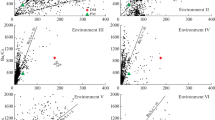Abstract
New major and trace element analyses are presented for 7 kaersutites from basic alkaline rocks. K/Rb ratios lie between 1209 and 4276. Rb is low, averaging 6 ppm. Sr ranges from 532 to 1060 ppm and Ba from 181 to 701 ppm. Zr averages 109 ppm, Nb 44 ppm and V 390 ppm. There is a moderate enrichment in light REE. Zn correlates with FeO + Fe2O3 but the concentrations of Ni, Co, Cr, Cu and Pb are variable. Large variations in trace element concentration in kaersutites reflect only small variations in the melt when the distribution coefficient for a given element strongly favours the amphibole.
Kaersutite is significant in the petrogenesis of alkaline rocks as a possible accessory phase in the upper mantle source regions, and as an important phase in the fractionation of basic alkaline liquids over a wide range of pressures.
Similar content being viewed by others
References
Aoki, K.: The kaersutites and oxykaersutites from alkalic rocks of Japan and surrounding areas. J. Petrol. 4, 198–210 (1963).
Baker, I.: Petrology of the Volcanic Rocks of Saint Helena Island, South Atlantic. Bull., Geol. Soc. Am. 80, 1283–1310 (1969).
Brown, F. H., Carmichael, I. S. E.: Quaternary volcanoes of the Lake Rudolf region: 1. The basanite-tephrite series of the Korath Range. Lithos 2, 239–260 (1969).
Gast, P. W.: Trace element fractionation and the origin of tholeiitic and alkaline magma types. Geochim cosmochim. Acta 32, 1057–1086 (1968).
Green, D. H.: A review of experimental evidence on the origin of basaltic and nephelinitic magmas. Phys. Earth Planet. Interiors 3, 221–235 (1970).
Griffin, W. L., Murthy, V. R.: Distribution of K, Rb, Sr and Ba in some minerals relevant to basalt genesis. Geochim. Cosmochim. Acta 33, 1389–1414 (1969).
Hart, S. R., Aldrich, L. T.: Fractionation of potassium/rubidium by amphiboles: Implications regarding mantle composition. Science 155, 325–327 (1967).
Higuchi, H., Nagasawa, H.: Partition of trace elements between rockforming minerals and the host volcanic rocks. Earth Planet. Sci. Lett. 7, 281–287 (1969).
Holloway, J. R., Burnham, C. W.: Melting of basalt with equilibrium water pressure less than total pressure. J. Petrol. 13, 1–29 (1972).
Irving, A. J.: Geochemical and high pressure experimental studies of xenoliths, megacrysts and basalts from southeastern Australia. Ph. D. thesis. Australian National University (1971).
Jakeš, P.: Analytical and experimental geochemistry of volcanic rocks from island arcs. Ph. D. thesis. Australian National University (1970).
Le Maitre, R. W.: Petrology of volcanic rocks, Gough Islands, South Atlantic. Bull. Geol. Soc. Am. 73, 1309–1340 (1962).
Le Maitre, R. W.: Kaersutite-bearing xenoliths from Tristan da Cunha. Mineral Mag. 37, 185–197 (1969).
Oxburgh, E. R.: Petrological evidence for the presence of amphibole in the upper mantle and its petrogenetic and geophysical implications. Geol. Mag. 101, 1–19 (1964).
Philpotts, J. A., Schnetzler, C. C.: Phenocryst-matrix partition coefficients for K, Rb, Sr and Ba, with applications to anorthosite and basalt genesis. Geochim. Cosmochim. Acta 34, 307–322 (1970).
Ridley, W. I.: The petrology of the Las Canadas Volcanoes, Tenerife, Canary Islands. Contr. Mineral. and Petrol. 26, 124–160 (1970).
Schetzler, C. C., Philpotts, J. A.: Partition coefficients of rare-earth elements between igneous matrix and rock-forming mineral phenocrysts II. Geochim. Cosmochim. Acta 34, 331–340 (1970).
Taylor, S. R.: The application of trace element data to problems in petrology. Physics and chemistry of the earth, vol. 6 (ed. L. H. Ahrens et al.), p. 133–213. London: Pergamon Press 1965.
Tuthill, R. L.: The hydrothermal behaviour of basalts in their melting range at 5 kilobars. M. Sc. thesis. Pennsylvania State University (1968).
White, A. J. R., Chappell, B. W., Jakeš, P.: Coexisting Clinopyroxene, Garnet and Amphibole from an “Eclogite”, Kakanui, New Zealand. Contr. Mineral. and Petrol. 34, 177–184 (1972).
Wilkinson, J. F. G.: Some aspects of the calciferous amphiboles, oxyhornblende, kaersutite and barkevikite. Am. Mineralogist 46, 340–354 (1961).
Wilkinson, J. F. G.: Mineralogical, geochemical, and petrogenetic aspects of an analcitebasalt from the New England district of New South Wales. J. Petrol. 3, 192–214 (1962).
Author information
Authors and Affiliations
Rights and permissions
About this article
Cite this article
Kesson, S., Price, R.C. The major and trace element chemistry of kaersutite and its bearing on the petrogenesis of alkaline rocks. Contr. Mineral. and Petrol. 35, 119–124 (1972). https://doi.org/10.1007/BF00370923
Received:
Issue Date:
DOI: https://doi.org/10.1007/BF00370923



